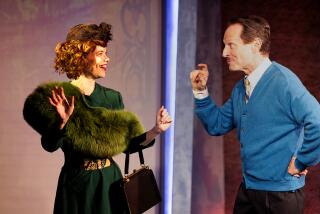End of a heroic line
- Share via
My first encounters with Charlton Heston took place inside cavernous old movie palaces on the Gran Via in Madrid, which advertised their movies on giant painted marquees. One of the advantages of growing up in late 1970s/early ‘80s Spain was that 40 years of isolationism combined with a serious latent cinephile culture made it possible for a 10-year-old to experience Charlton Heston as nature and (surely) God intended: on enormous screens in ornate city theaters and on Saturday-morning TV, instead of cartoons.
My brother and I were taken to see “Ben-Hur” and “The Ten Commandments” by our mother, whose excitement at finding the movies again was infectious. She’d seen them when they first came out in the mid- to late-’50s, in the brand-new twin marvels of widescreen and stereo, when she herself was 10 and later 13. She and her sister had donned hats and white gloves to accompany their parents to the elegant Cine Metro in downtown Lima, Peru, all red velvet and gold leaf, where they ran into everyone they knew. Charlton Heston was perhaps the only actor who could fully inhabit the whole experience, which she remembered as momentous and magical. Twenty-five years later, in the late 1970s, we experienced him through her eyes first, awed by the legendary hero of grand-scale biblical epics whose noble suffering and superhuman endurance were just barely being matched by Christopher Reeve’s “Superman.” Massive, brooding, a mountain of barely suppressed righteous anger, Heston seemed entirely capable of single-handedly saving whomever was in need of saving, as he was concurrently being called upon repeatedly to do.
If my mother, by a fluke of geography and timing, was able to replicate for me the experience of seeing Heston, the last great movie star, as he was seen by millions in his heyday, there is very little chance that I’ll be able to do the same. It’s not just that the Cine Metro in Lima has long since closed down, as have 10 of the grand 1920s movie theaters that lined the Gran Via in Madrid, all of them replaced by state-of-the-art multiplexes across town and in the suburbs. Or that those that have survived in Hollywood ensured their survival by turning entirely to first-run major studio releases. It’s that, if Charlton Heston were a young star today, there would be no context in which he could be, well, Charlton Heston.
It’s not just that Heston played the epic hero throughout most of his career, it’s that he embodied postwar America, a younger, more vital, less morally compromised America in a way that it’s no longer possible to do. Heston’s signature heroes were not the triumphalist uber-beings that actors like Arnold Schwarzenegger, Heston’s late-century counterpart, would later embody. They were downtrodden and oppressed, the strength of their convictions an equal match for the brute strength of his body. To behold Heston in chains, behind bars or even in a morally compromised situation was to behold the classical ideals of moral clarity, youthful vigor and civilization oppressed by the depraved, the primitive, the corrupt. He stood, he observed, he suffered. Heston’s muscular body and hard, determined jaw were made to endure injustice, to absorb and transform it into virtuous action. His roles as a biblical or early Christian hero and redeemer (Moses in “The Ten Commandments,” John the Baptist in “The Greatest Story Ever Told” and Judah Ben-Hur in “Ben-Hur”), virtuous unappreciated lawman (“Touch of Evil”) and misunderstood warrior branded a traitor (Rodrigo Diaz de Vivar in “El Cid” and Marc Antony, twice) presaged later pop-Messianic roles -- “Airport 1975” among them.
By then, having played the last man on Earth (“The Omega Man,” 1971) and the only man (symbolically) on an Earth ruled by apes (“Planet of the Apes,” 1968), he’d earned the right to play savior in more mundane situations. Hence the rescue pilot, whom Roger Ebert described in his reviews as “Charlton Heston, inevitably” lowered into the gaping hole of a large jet aircraft in mid-flight to single-handedly rescue the helpless passengers and crews on-board.
By “Earthquake” (1974) and “Midway” (1976), both in the brand-new marvel of Sensurround!, the Heston hero had hardened into kitsch, and these performances as well as these films mark the end of an era. In “Midway,” he cuts through the movie’s relativist muddle to personally climb into a plane and take down the last Japanese aircraft carrier standing. It’s like he had to do everything around here.
Perhaps the steady stream of parts in which Heston played the upright individual unjustly targeted by a morally turbid establishment led to the actor’s entrenchment in later years as a conservative firebrand, an inclination that culminated in his heading the National Rifle Assn. and his appearing, memorably and upsettingly, in Michael Moore’s “Bowling for Columbine.” Already ill with Alzheimer’s, Heston appeared to have taken all those stories of corruption and disaster to heart. Barricaded in a fortified mansion inside a gated, heavily patrolled community, his answers to Moore’s questions came across as removed from the world as it’s possible to be.
Heroes, of course, were made to be killed, and it’s fitting that Heston’s star would be somewhat tarnished by his politics late in his life. But it would be a shame to remember him this way. Heston represented an era of grandeur and innocence, before the movies were called “events” but actually were experiences to be remembered for a lifetime.
--
More to Read
Only good movies
Get the Indie Focus newsletter, Mark Olsen's weekly guide to the world of cinema.
You may occasionally receive promotional content from the Los Angeles Times.










